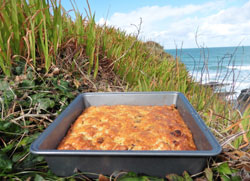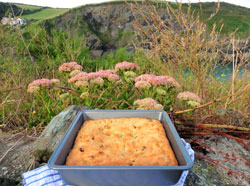When Cornish pilchard fishing was at its height, in the 18th and 19th
centuries a look-out or ‘huer’ would be stationed up on the cliffs to
keep watch for shoals. When one swam into sight – seen as a red shadow
just under the surface - he’d cry: “He-vva!” to alert the boats before
signaling them to the exact spot.

Cornish people love their cakes and fishermen are no exception. Once
the nets were cast the huer might nip back into his hut and bake hevva
cake for their return. Paid with a percentage of the catch, the cake may
have secured an extra bonus!
Quick and economical to make, hevva cake was marked with a crisscross
pattern to represent the nets: some say the currants represent the fish
caught inside.
Recipes vary: some use lard or margarine but butter gives the best
best of all - Cornish butter ideally! Spices may be added or the top
sprinkled with sugar. Traditionally, the stiff dough is rolled a shallow
1-2cm thick on a baking tray; this is a slightly moister, deeper
version baked in a tin.
Makes 8 slices
- 250g plain flour
- 1 level teaspoon bicarbonate of soda
- 2 level teaspoons cream of tartar
- 125g salted butter, diced
- 100g granulated sugar (or caster)
- 100g currants (or raisins/sultanas or mixed)
- 150ml milk
- Milk or beaten egg to glaze
Preheat oven to 180C (fan ovens) or equivalent
You will need a square 21cm cake tin: the bottom lined with greaseproof paper
Sieve flour and raising agents into a bowl. Rub in butter. Stir in
sugar and fruit. Work in milk gradually with the handle of a wooden
spoon.
Gather up dough and any loose crumbs and knead gently into a ball. Press gently into tin.
Brush with milk or well-beaten egg and a drop of water.
Bake for 10-20 minutes until golden and a skewer inserted comes out clean. Eat warm or cold with a cup of strong tea.

Note
You may notice it’s fairly difficult to etch a
crisscross pattern in the top of this version. That’s because it’s a
slightly richer mix or as they say in Cornwall (usually of crumbly pasty
pastry): ‘there’s too much goodness in it!’